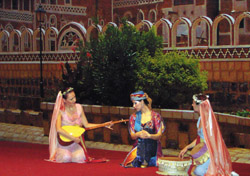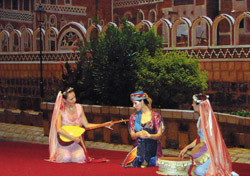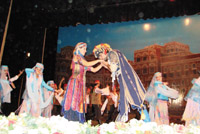
Syrian Cultural Week: Presenting Syria to Yemen [Archives:2008/1159/Last Page]
May 29 2008
 |
 |
Photos curtsy of 26 September Establishment, by Hamdi Al-Saeedi
Alongside the Supreme Yemeni Syrian Committee meetings that took place earlier this month, Syrian Cultural Week was held from May 11 – 16, corresponding with the official inauguration of the Syrian Cultural Center in Sana'a.
During the second week of May, many Syrian officials and artists came to Yemen to organize the Syrian Cultural Week as a part of promoting Damascus as the 2008 Arab cultural capital.
During the week, Yemeni citizens were introduced to Syrian culture, which included music, art, dances, history and even the media. Simultaneously, Syrian officials met with their Yemeni counterparts and agreed on a number of future cooperation activities and projects. According to ambassador Abdul Ghafour Sabouni, Syria gives more educational scholarships to Yemenis than any other country, with over 180 scholarships in various fields every year.
On the same occasion, an agreement on youth and cultural activities was signed between Yemeni and Syrian officials in order to encourage cultural and educational exchange between the two countries.
Dance, music and a fashion show
Forty dancers of the artistic group “Anana” participated in the Syrian Culture Week and delighted the audience with their dances and performances. “Starry Night” was the title of the night show performed by Anana, also known as the Syrian Art Ambassador.
This dance performance depicted the Damascus Sword Story with the heroism of Mohammed Emairi and Reem Abd Shahata as well as showing the traditional folk dances of Damascus, in addition to sketches on the known “Cafe”, “Karakoz” and “Al-Soufiyah” legends.
Anana was established in 1990 and includes 70 professional female and male dancers as well as 50 amateurs. The word “Anana” refers to the ancient Syrian god of love, fertility, culture, art, and literature The band takes its inspiration from Arab history and culture, especially in the Levant area. They try to fuse reality and myth and tradition as well as modernization.
The group also played in Aden and Hadramout during the culture week.
Also in the cultural week, were many singing sessions where the Syrian traditional music was played. Melodies mixed technical art and western instruments with traditional ones.
Musical Group “Shiookh Salateen Al-Tarab” performed a number of songs and melodies based on the halabia school of music during the festival. The group tries to revive neglected songs and traditional music in an attempt to keep the culture alive. The artists have levels according to their talent, as one who is very good is at the top of the ladder and is called a “sheikh”, while a “sultan” is a good performer but not as good as the sheikh.
There was also a fashion show that displayed Syrian traditional and modern costumes and the bright colors and Syrian embroidery famous around the world. The show dedicated different styles of dress based on the region and orientation, such as cities and suburbs or different towns.
Exhibitions
There were 31 different paintings on display in a showroom designed for the Syrian artists, with each painting reflecting their talents and experiences. The paintings ranged from historical and natural scenes to modern art.
There was also an exhibition for Arabic calligraphy, which is famous in Syria. The exhibition contained 25 outstanding showpieces of handwriting by Syrian calligraphers.
Simultaneously, there was a book fair organized by the Syrian Ministry of Culture, with more than 400 titles from different fields. Many were Arabic titles, while others were translated from foreign languages into Arabic.
There was also an exhibition for handcrafts and traditional ceramic and brass utensils, in addition to samples of world-renowned Syrian carpets.
The cultural week also included a photo exhibition, in which professional pictures reflecting natural and modern Syrian landscapes as well as traditional handcraft markets and historical cities. Most Syrian cities were present in the photography display, such as Damascus, Halab and Homah, bringing Yemeni audiences one step closer to Syria.
Lectures and movies
While entertainment was the major part of the cultural week, some intellectual events and presentations also took place at the Yemeni Cultural House and the Syrian Cultural center among other places.
Lectures on Syrian heritage and links between Yemeni and Syrian cultures took place. Ali Al-Gaiym, the Syrian culture minister's assistant, explained that there are more than 800 archeological and historical locations in Syria, as well as over 200 tourist villages. He also praised Yemeni architecture, saying that is the most unique in the world, particularly Old Sana'a.
Also, Syrian researcher Mohammed Gajah presented a lecture titled “Andalusian pioneers of Yemeni origins” at the Sana'a University Faculty of Education.
A number of various Syrian movies were on display such as “Under the Ceiling”, directed by Nedhal Al-Dabes, “The Spirit's Breeze”, directed by Abdullateef Abdullhameed, “Strangers' Traces”, directed by Sameer Dhakra, and “Dreamful Perspectives”, directed by Waha Al-Raheb and produced by the General Institution for Cinema in Syria.
At the Sana'a Cultural Center, a lecture about the Arabic cultural situation in Syria was presented by Syrian Minister of Culture Riyadh Nassan Agha. He narrated the different stages the Arab nation has gone through up to the present day, concluding with the choosing of Syria as the capital of Arabic culture this year.
He emphasized on the important Islamic principles of co-existence and accepting others, reminding the audience that Islam originated from the Arabian Peninsula, while Christianity originated from the Levant especially Syria.
Another lecture entitled “Syria as the Foundation of Civilizations” was presented by Basam Jamos, General Manager of Syrian Archeology and Museums.
——
[archive-e:1159-v:18-y:2008-d:2008-05-29-p:lastpage]


